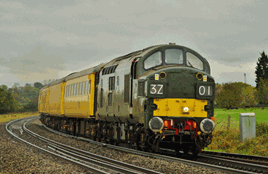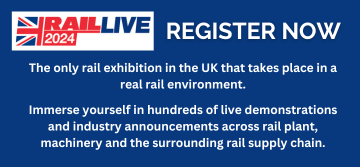HNRC continues to be in the market for more locomotives and was looking to conclude a deal for two more preserved but unserviceable Class 31s. This, Needle says, is because certain locomotives that could be made available to the market are not, and so he must look at alternative options to supply various contracts.
The number of locomotives returning to traffic with DRS has dramatically reduced. The company had been active in the market in recent years, and acquired 37407/413/424, 37503/521, 37670, 37703/714/716/718 while agreeing a deal to hire 37403 from preservation.
However, a change in traction policy combined with changing fleet requirements means a number of these are now deemed surplus. It is understood that some could be made available for sale but the company, when asked, said its traction policy was “confidential”. Nevertheless 37718 has already been sold for scrap, and was cut-up by Booths during the summer having donated components at Derby.
Two Class 37/4s, 37407 and 37424, will return to traffic in February following comprehensive rebuilds at Railway Vehicle Engineering Ltd’s (RVEL’s) Derby workshops. They will join a fleet of Class 37/4s already in use with DRS and hired to passenger operators. The versatility of the electric train heat fitted locomotives makes them attractive for DRS which aims to supply not only the freight market but also the passenger sector.
DRS has also expanded its Class 57/3 fleet by adding a further six machines to its fleet of six, meaning it has all 12 of the original Class 57/3 fleet ordered by Virgin Trains that entered traffic from 2002. These have been introduced into the fleet and have replaced Class 47s.
Smaller operators have also been active in the market.
Nemesis Rail added 47701 to its fleet in 2014. The Class 47/7 has been made operational and is on hire to British American Railway Services (BARS) at Dartmoor Railway. The Type 4 was based at the Devon railway when it was privately owned. It was once used on the main line, but was withdrawn from that in 2003 as it required TPWS. Along with 33103 Swordfish and 45112 it is one of only three operational Nemesis Rail locomotives, and none is currently passed for the main line.
The company does, however, have a number of locomotives allocated to its main line pool but none are capable of operating. In the pool are 31289, 31461, 33019, 33103, 37255, 45112, 47488, 47640, 47744 and 73114. These are at various heritage railways or Nemesis Rail’s Burton facility (31461, 45112, 47488, 47744). One locomotive that was passed for the main line, 47375, has been exported to Hungary, but by mid-December had only reached Amsterdam.
West Coast Railways has bought one Class 37 (37518) from Ian Riley and two Class 47s from Direct Rail Services (47802/832) that were stored for a few months before being disposed of. All three are part of the active WCR fleet.
While it is hiring Class 73/9s from GBRf, Network Rail has two of the rebuilt Class 73s of its own on its books, although neither has been passed for main line work yet. The locomotives are 73951 and 73952. Both are undergoing testing and once this is complete they will be acquired by NR. They have been rebuilt by RVEL at Derby from 73104 and 73211. Both had been out of traffic for many years.
Elsewhere, two Class 37/7s once used in Spain are set for a lengthy return to the main line. Europhoenix (EP) acquired 37800 and 37884 from EMR after they were returned from Spain. The ‘37s’ had been bought by the scrap merchant from DB, and were then re-sold to EP. The company has had them returned to main line standards and they have subsequently been hired to ROG for rail services. They have had their ballast removed, which reduces their weight and increases their route availability meaning that they become more operationally attractive as they can operate on other routes.
So far 37884 has returned to traffic following overhaul by HNRC at Barrow Hill. It will be joined by 37800, which is at UK Rail Leasing’s Leicester depot.
They were exported to France in 2001 by EWS. Along with DRS 37716 it means that three of the Class 37s sent to Spain have returned to main line use in this country, even if they are more than 50 years old. A further two (37703/714) are on DRS’ books but not active on the main line.
Also at UKRL, a number of Class 56s are being returned to the main line (see Fleet News, pages 12-13). Many have been out of use since their return to the UK from France where they were on contract hire to Fertis from EWS.
One recent returnee was 56098, which did not go to France, but instead was preserved before returning to the main line. It joined 56081 and 56104 which had been abroad. The latter was bought from EMR having been sold by DB.
Two Class 33s previously bought for preservation are also destined for main line careers with UKRL. One (33008) has never worked in preservation and has been owned by DRS and HNRC since being sold by EWS, while 33053 has worked in preservation but is currently unserviceable. They were withdrawn in February 1996 and January 1995 respectively.
Withdrawn by British Rail in March 1994 after a 27-year career on the main line, Class 50s have returned with a vengeance. Two - 50007 Hercules and 50017 Royal Oak - have been bought by Boden Rail Engineering Ltd (BREL), from preservation and returned to the main line, with 50050 Fearless set to join them.
While 50007/050 were two of the final three to be withdrawn, Royal Oak was withdrawn in September 1991. It had been on the main line before, around the turn of the century when hired to Venice-Simplon Orient Express but was then resold and ended up at the Plym Valley Railway. The two main line locomotives based there at one point (37207 and 50017) have both been bought by main line companies. BREL has hired its ‘50s’ at various points to Colas for freight work, including steel trains to Boston.
A Class 20 withdrawn in 1989 and preserved the following decade is now back on the main line. Class 20 Locomotive Society 20205 has been hired to GBRf for shunting in East London, but has also been used by DCRail. The Type 1 usually operates with the CTLS’ 20227 and both are deemed preserved.
Finally, not all locomotives bought by main line operators are destined for a return to the main line. At the Severn Valley Railway 20177 has been bought for component recovery, as has 33046 at the East Lancashire Railway.
What does the future hold? Could more preserved locomotives return to the main line? Given the apparently insatiable demand for these versatile veterans and the lack of readily available modern alternatives, it would be foolish to bet against it.
- This feature was published in RAIL 791 on January 6 2016















Comment as guest
Comments
FrankH - 25/02/2016 03:51
I'm surprised no freight operator took an option to to buy any of the refurbished class 86 and 87's that went to Europe. The Wembley Euro Freight centre - Daventry - Coatbridge/Mossend route would've been ideal for them. It's a pity the 92's rotting at Crewe arn't in anyones minds, 1 of those = a 1600 ton train over shap and beatock vs 2 66's or 2 86's/90's. DB reckons they're a lot more expensive to run vs a 90 which may be why they've stopped using them, or is it because they now have spare 90's having lost the CS sleeper contract.
Reply as guest